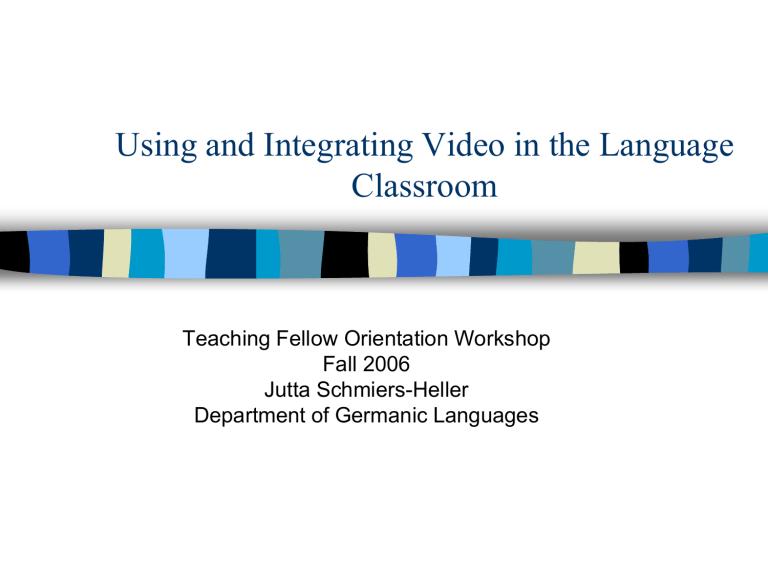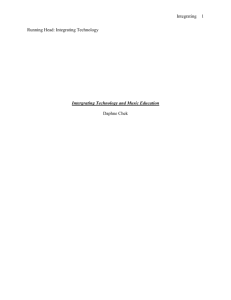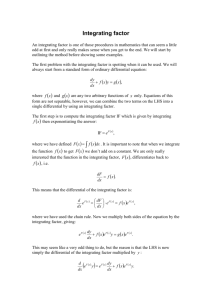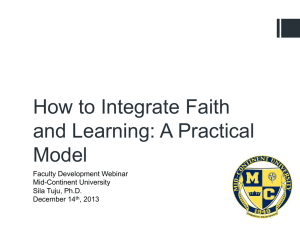Using and Integrating Video in the Language Classroom

Using and Integrating Video in the Language
Classroom
Teaching Fellow Orientation Workshop
Fall 2006
Jutta Schmiers-Heller
Department of Germanic Languages
Introduction
Effective use of authentic video in the classroom normally requires much thought and preparation on the part of the instructor.
Fall 2005 Using and Integrating Video in the
Language Classroom
2
Some Pedagogical Assumptions
Authentic video can be used at any level of instruction if the task level (and not necessarily the linguistic level) of the video is appropriate to the learning level of the class.
“ Understanding ” video does not entail understanding every word, but learning to glean meaning from linguistic and visual cues.
Successful exploitation of a short video segment can provide material for many minutes (even hours), of linguistically meaningful activities.
Video segments need to be viewed more than once, with each viewing involving a different task.
Fall 2005 Using and Integrating Video in the
Language Classroom
3
Some Pedagogical Assumptions
(cont.)
Video can serve as a springboard for a wide variety of activities, from listening comprehension to cultural understanding, and from critical thinking to creative role-playing.
Comprehension is aided if students are allowed to activate their existing knowledge and expectations about the content of a video before viewing.
Real language use focuses on meaning and communication rather than on form.
Video materials should be integrated thematically into the rest of the course syllabus. (Crapotta, 2002)
Fall 2005 Using and Integrating Video in the
Language Classroom
4
Selecting Authentic Video
In selecting authentic video the instructor has to take into consideration the following questions:
• Who ? [target group: age, linguistic abilities, prior knowledge, emotional component]
• What ? [what sequence for what goals, length]
• Why ? [why should the material be used?]
• How ? [how is the material going to be used?]
(Motyl & Whiteman, 1995)
Fall 2005 Using and Integrating Video in the
Language Classroom
5
General Possibilities for
Exploiting Videotexts
Play only on part and have students hypothesize and save the punch line for later.
Replay sequences (or entire video) for more detailed viewing. Use pause/still frame.
Interrupt viewing to check comprehension.
Cut off sound to focus on image.
Replace soundtrack with own narration or ask students to narrate.
Select certain sequences for out-of-class viewing.
View with or without scripts.
Fall 2005 Using and Integrating Video in the
Language Classroom
6
Creating a Lesson Plan using
Authentic Video
There are three components or general strategies to a lesson plan using authentic video:
• Preparation (Pre-Viewing)
• Presentation (Viewing and Post-Viewing)
• Expansion (Beyond Post-Viewing)
Each component or strategy is connected with specific goals and activities.
(Shrum & Glisan, 2005 & Altman, 1999, et al.)
Fall 2005 Using and Integrating Video in the
Language Classroom
7
Preparation (Pre-Viewing Activities)
Goals:
– Activate existing knowledge, determine current knowledge, establish hypotheses, motivate.
Activities:
– Brainstorming through using stills, using the title to form hypotheses about the content, review vocabulary, etc.
[For more see Altman et al. and http://www.columbia.edu/itc/german/korb/middlebu ry/strategien.html]
Fall 2005 Using and Integrating Video in the
Language Classroom
8
Presentation (Viewing and Post-
Viewing Activities)
Goals:
– Global vs. detailed understanding, encourage active viewing, making students aware of comprehension strategies.
Activities:
– Viewing without sound, listening without images, full viewing, skills-Oriented task (comprehension vs. comprehension plus production), cultureoriented tasks, script-oriented tasks, etc.
Fall 2005 Using and Integrating Video in the
Language Classroom
9
Expansion (Beyond Post-Viewing
Activities)
Goals: use of vocabulary, structures, and cultural information presented beyond the work with the sequence.
Activities:
• Play game, work puzzle
• Build or make something
• Read related material
• Students re-write script or dialog
• Student-produced videos
• Etc.
(for more information see Shrum& Glisan and Altman et al.)
Sample
Fall 2005 Using and Integrating Video in the
Language Classroom
10
Some “ Words of Wisdom ”
Selection of appropriate video materials not always an individual decision.
All textbooks come with materials, but…
Consider use of video materials inside and outside of class.
ON a more technical note: Make sure the video and the VCR you are planning to use work.
Famous last words: Always have a back-up!
Sample(s)
Fall 2005 Using and Integrating Video in the
Language Classroom
11
References
Altman, R. et al. (1999). PICS Tips & Treats: PICS
Videoguidelines.
Retrieved August 14, 2002 from The University of Iowa Website: http://www.uiowa.edu/~pics/tips.html
Altman, R. (1989). The Video Connection: Integrating Video
Into Language Teaching.
Boston : Houghton Mifflin.
Crapotta, J. (2002). Using and Integrating Authentic Video in the
Language Classroom . Handout from video workshop given on
February 15, 2002.
Korb, Richard. [all in German
☺
] http://www.columbia.edu/itc/german/korb/middlebury/middlebury_i ndexframe.html
Motyl, I. & Whiteman, J. (1995). Deutsche Welle. Aktuelle
Fernsehesendungen im kommunikativen Deutschunterricht .
Goethe House New York.
Shrum, J. & Glisan, E. (2005). Teacher ’ s Handbook:
Contextualized Language Instruction.
Boston : Heinle & Heinle.
Fall 2005 Using and Integrating Video in the
Language Classroom
12











